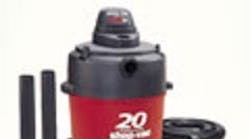Plugged or restricted drain lines on air conditioners have the potential to cause serious property damage. Wet and falling ceiling tiles, damaged office furniture, and soaked carpet are just a few examples of what can happen if drain lines aren't properly maintained. And don't forget the possible mold issues.
In a perfect world, all equipment would have overflow pans, and secondary drain lines. But until we find this magical place, we'll have to do the best we can with less than perfect installations.
Cleaning drain lines isn't always the easiest task. Blowing them out with CO2 is probably the most common method, but it's not always the most effective. Sometimes, no matter how much CO2 you use, you can't clear the line. The stuff that's blocking it is like glue.
However, there are many situations in which CO2 fails, yet a good shop vac can succeed.
For example, let's say you want to use the CO2 method on a drain, but you can't reach the inlet. You either have to take it apart, or blow the gunk backwards through the trap — where it will likely get stuck again. A shop vac, on the other hand, will pull all the junk out of the line and the trap.
Shop vacs also work well when you have multiple units tapped into a common drain. Find the end of the common drain and draw from there.
I know drain pan treatments would solve a lot of these problems, but getting customers to pay for them and the time to put them in is another story, especially if you're dealing with a building that has 100 or more heat pumps.
There's no advice I can give that will make getting the slime out of drain lines a fun job. But the shop vac method is relatively easy and very effective.
Now the only problem you'll have is to make sure you clean out that alien life form that used to be in the drain line . . . but is now living in your vacuum.
Dave Galbreath is the service manager at Seaman's Heating/Air Conditioning/Refrigeration in Grand Rapids, MI. He can be reached at 616/458-1544.











